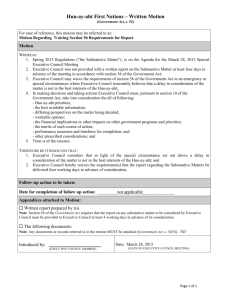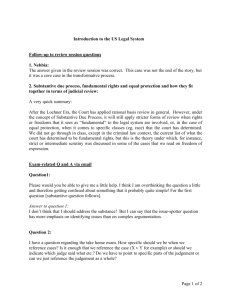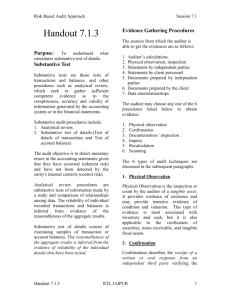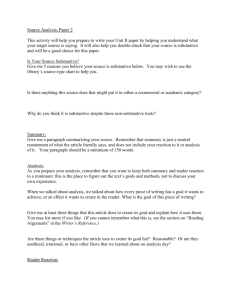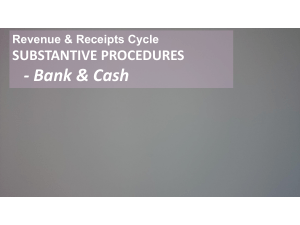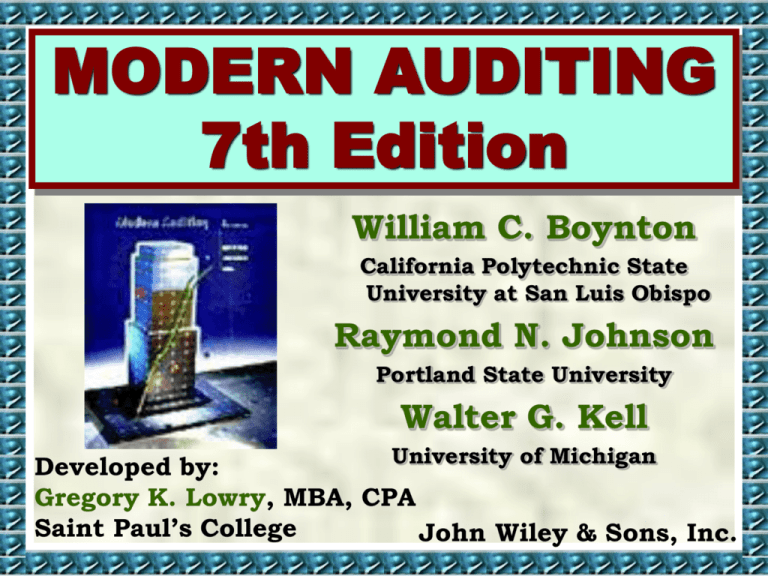
MODERN AUDITING
7th Edition
William C. Boynton
California Polytechnic State
University at San Luis Obispo
Raymond N. Johnson
Portland State University
Walter G. Kell
University of Michigan
Developed by:
Gregory K. Lowry, MBA, CPA
Saint Paul’s College
John Wiley & Sons, Inc.
CHAPTER 11
DETECTION RISK AND THE DESIGN OF
SUBSTANTIVE TESTS
Determining Detection Risk
Designing Substantive Tests
Developing Audit Programs for
Substantive Tests
Special Consideration in Designing
Substantive Tests
Determining Detection Risk
Regardless of whether the auditor chooses to
use quantitative or nonquantitative expressions
of the risk levels, planned detection risk is
determined based on the relationships expressed
in the following model:
DR = AR ÷ (IR x CR)
Evaluating the Planned Level
of Substantive Tests
When evaluating the planned level of substantive tests
for each significant financial statement assertion, the
auditor will consider the evidence obtained from:
1. The assessment of inherent risk.
2. Procedures to understand the business and industry
and related analytical procedures that have been
completed.
3. Tests of controls including:
a. Evidence about the effectiveness of internal
controls gained while obtaining an understanding
of internal controls.
b. Evidence about the effectiveness of internal
controls supporting a lower assessed level of control
risk.
Preliminary Audit Strategy,
Planned Detection Risk, and
Planned Emphasis on Audit Tests
Figure 11-1
Preliminary
Audit
Strategy
Planned
Detection
Risk
Planned
Assurance
Obtained
From
Planned
Level of
Substantive
Tests
A primarily
substantive
approach
emphasizing
detail tests
Low or
very low
Tests of details of
transactions and
balances
Higher level
A lower assessed
level of control
risk
Moderate
or high
Tests of controls
Lower level
A primarily
substantive
approach
emphasizing
analytical
procedures
Low or
very low
Analytical procedures
Higher level
Emphasis on
inherent risk and
analytical
procedures
Moderate
or high
Evidence regarding
inherent risk and
analytical procedures
Moederate or lower level
Specifying Detection Risk for Different
Substantive Tests of the Same Assertion
The term detection risk refers to the
risk that all the substantive tests used
to obtain evidence about an assertion
will collectively fail to detect a
material misstatement. In designing
substantive test, the auditor may want
to specify different detection risk
levels to be used with different
substantive tests of the same
assertion.
Designing Substantive Tests
The nature of substantive tests refers
to the type and effectiveness of the
auditing procedures to be performed.
1. When the acceptable level of
detection risk is low, the auditor
must use more effective, and usually
more costly, procedures.
2. When the acceptable level of
detection risk is high, less and less
costly procedures can be used.
Designing Substantive Tests
Analytical procedures in audit planning are used to
support top-down audit strategies and to identify
areas of greater risk of misstatement. Analytical
procedures may also be used in the testing phase of
the audit as a substantive test to obtain evidence
about a particular assertion.
AU 329.11, Analytical Procedures (SAS 56),
indicates that the expected effectiveness and
efficiency of analytical procedures depends on the:
1. Nature of the assertion
2. Plausibility and predictability of the relationship
3. Availability and reliability of the data used to
develop the expectation
4. Precision of the expectation
Designing Substantive Tests
Tests of details of transactions primarily involve tracing
and vouching.
Tests of details of balances focus on obtaining evidence
directly about an account balance rather than the
individual debits and credits comprising the balance.
The following illustrates how the effectiveness of tests of
balances can be tailored to meet difference detection
risk levels for the valuation or allocation assertion for
cash in bank:
DETECTION RISK
High
Moderate
Low
Very Low
TESTS OF DETAILS OF BALANCES
Scan client-prepared bank reconciliation and verify
mathematical accuracy of reconciliation.
Review client-prepared bank reconciliation and verify major
reconciling items and mathematical accuracy of reconciliation.
Prepare bank reconciliation using bank statement obtained from
client and verify major reconciling items and mathematical
accuracy.
Obtain bank statement directly from bank, prepare bank
reconciliation, and verify all reconciling items and mathematical
accuracy.
Designing Substantive Tests
An accounting estimate is an approximation of a
financial statement element, item, or account in the
absence of exact measurement.
Tests of accounting estimates usually involve testing
balances, but usually require unique evidence.
AU 342.07, Auditing Accounting Estimates (SAS 57),
states that the auditor’s objective in evaluating
accounting estimates is to obtain sufficient competent
evidential matter to provide reasonable assurance that:
1. All accounting estimates that could be material to the
financial statements have been developed.
2. The accounting estimates are reasonable in the
circumstances.
3. The accounting estimates are presented in conformity
with applicable accounting principles and are properly
disclosed.
Designing Substantive Tests
The acceptable level of detection risk
may affect the timing of substantive
tests.
1. If detection risk is high, the tests
may be performed several months
before the end of the year.
2. When detection risk for an assertion
is low, the substantive tests will
normally be performed at or near
the balance sheet date.
Designing Substantive Tests
More evidence is needed to achieve a
low acceptable level of detection risk
than a high detection risk.
The auditor can vary the amount of
evidence obtained by changing the
extent of substantive tests performed.
Extent is used in practice to mean the
number of items or sample size to
which a particular test or procedure is
applied.
Relationships among Audit Risk Components and
the Nature, Timing, and Extent of Substantive Tests
Figure 11-2
Developing Audit Programs for
Substantive Tests
One common type of audit software in use today is
known as generalized audit software. Such software
is adaptable for use by auditors for clients’
computer files produced under a variety of data
organization and processing methods.
The computer can be programmed to select audit
samples according to whatever criteria are specified
by the auditor. These samples can be used for a
variety of purposes.
Another common use of the computer is to test the
accuracy of computations in machine-readable data
files. Tests of extensions, footing, or other
computations may be performed.
Developing Audit Programs for
Substantive Tests
The auditor frequently desires to have the
client data reorganized in a manner that will
suit a special purpose. Similarly, in
performing analytical procedures, the auditor
may utilize the computer to compute desired
ratios and other comparative data.
Audited data resulting from work performed
by the auditor may be compared with
information in the computer records. The
audited data must, of course, first be
converted into machine-readable form.
Illustration of Assertions, Specific Audit Objectives,
and Substantive Tests
Figure 11-3
Assertion
Existence or
Occurrence
Specific
Audit
Objective
Examples of
Substantive
Tests
Inventories included in the
balance sheet physically
exist.
Observe physical inventory
counts.
Obtain confirmation of
inventories at locations
outside the entity.
Additions to inventories
represent transactions that
occurred in the current
period.
Test cutoff procedures for
purchases, movement of
goods through
manufacturing, and sales.
Inventories represent items
held for sale or used in the
normal course of business.
Review perpetual inventory
records, production
records, and purchasing
records for indications of
current activity.
Compare inventories with a
current sales catalog and
subsequent sales and
delivery reports.
Assertion
Completeness
Specific
Audit
Objective
Examples of
Substantive
Tests
Inventory quantities
include all products,
materials, and supplies on
hand.
Observe physical inventory
counts.
Account for all inventory
tags and count sheets used
in making the physical
inventory counts.
Analytically review the
relationship of inventory
balances to recent
purchasing, production,
and sales activities.
Test cutoff procedures for
purchases, movement of
goods through
manufacturing, and sales.
Inventory quantities
include all products,
materials, and supplies
owned by the company that
are in transit or stored at
outside locations.
Obtain confirmation of
inventories at locations
outside the entity.
Analytically review the
relationship of inventory
balances to recent
purchasing, production,
and sales activities.
Test cutoff procedures for
purchases, movement of
goods through
manufacturing, and sales.
Assertion
Rights and
Obligations
Specific
Audit
Objective
Examples of
Substantive
Tests
The entity has legal title or
similar rights of ownership
to the inventories.
Observe physical inventory
counts.
Obtain confirmation of
inventories at locations
outside the entity.
Examine paid vendors’
invoices, consignment
agreements, and contracts.
Inventories exclude items
billed to customers or
owned by others.
Examine paid vendors’
invoices, consignment
agreements, and contracts.
Test cutoff procedures for
purchases, movement of
goods through
manufacturing, and sales.
Assertion
Valuation or
Allocation
Specific
Audit
Objective
Examples of
Substantive
Tests
Inventory records are
accurately compiled and
the totals are properly
included in the inventory
accounts.
Review activity in general
ledger accounts for
inventories and investigate
unusual items.
Verify extensions of
quantities times unit prices
and totals of inventory
records, and agreement
with general ledger.
Trace test counts recorded
during physical inventory
observation to inventory
records.
Reconcile physical counts
to perpetual records and
general ledger balances and
investigate significant
fluctuations.
Inventories are properly
stated at cost (except when
market is lower).
Examine paid vendors’
invoices.
Review direct labor rates.
Test computations of
standard overhead rates
and standard costs, if
applicable.
Examine analyses of
purchasing and
manufacturing standard
cost variances, if
applicable.
Assertion
Valuation or
Allocation
Specific
Audit
Objective
Examples of
Substantive
Tests
Slow-moving, excess,
defective, and obsolete
items included in
inventories are properly
identified.
Inquire of production and
sales personnel concerning
possible excess or obsolete
inventory items.
Examine an analysis of
inventory turnover.
Review industry experience
and trends.
Analytically review the
relationship of inventory
balances to anticipated
sales volume.
Inventories are reduced,
when appropriate, to
replacement cost or to net
realizable value.
Obtain current market
value quotations.
Evaluate net realizable
value.
Assertion
Presentation and
Disclosure
Specific
Audit
Objective
Examples of
Substantive
Tests
Inventories are properly
classified in the balance
sheet as current assets.
Review drafts of the
financial statements.
The basis of valuation is
adequately disclosed in the
financial statements.
Compare the disclosures
made in the financial
statements to the
requirements of generally
accepted accounting
principles.
The pledge or assignment
of any inventories is
appropriately disclosed.
Obtain confirmation of
inventories assigned or
pledged under loan
agreements.
Developing Audit Programs for
Substantive Tests
The auditor’s decisions regarding the design of
substantive tests are required to be documented in the
working papers in the form of written audit programs
(AU 311.09). An audit program is a list of audit
procedures to be performed.
In addition to listing audit procedures, each audit
program should have columns for:
1. A cross-reference to other working papers containing
the evidence obtained from each procedure (when
applicable),
2. the initials of the auditor who performed each
procedure, and
3. the date the performance of the procedure was
completed.
Developing Audit Programs for
Substantive Tests
Audit programs should be
sufficiently detailed to provide:
1. An outline of the work to be
done
2. A basis for coordinating,
supervising, and controlling
the audit
3. A record of the work performed
Developing Audit Programs for
Substantive Tests
We can construct a general framework for developing
audit programs for substantive tests. Such an approach
is described in Figure 11-5.
The steps listed in the upper portion of Figure 11-5
summarize the application of several important concepts
and procedures explained in Chapters 5 through 10.
2 additional examples of analogous steps in other areas
of the audit are as follows:
1. verifying the totals and determining the agreement of
the general ledger accounts receivable control account
and the accounts receivable subsidiary ledger and
2. verifying the totals and determining the agreement of
a general ledger investment portfolio account and a
spreadsheet listing the details of the related
investments.
General Framework for Developing Audit
Programs for Substantive Tests
Figure 11-5
Complete Audit Planning
1. Identify the financial statement assertions to be
covered by the audit program.
2. Develop specific audit objectives for each category of
assertions.
3. Obtain an understanding of the client’s business and
industry including such items as the client’s business
cycle, management’s goals and objectives,
organizational resources, the entity’s products,
services market, customers, competition, the entity’s
core processes and operating cycle, and the entity’s
investing and financing decisions.
4. Assess inherent risk for the assertion.
General Framework for Developing Audit
Programs for Substantive Tests
Figure 11-5
5. Assess control risk for the assertion based on:
Evidence of the effectiveness of controls gained
while obtaining an understanding of internal
controls.
Evidence of the effectiveness of management
controls or other manual controls over computer
output.
Evidence of the effectiveness of computer control
procedures including manual follow-up.
6. Determine the final level of detection risk for each
assertion consistent with the overall level of audit
risk and applicable materiality level.
General Framework for Developing Audit
Programs for Substantive Tests
Figure 11-5
7. From knowledge acquired from procedures to obtain
an understanding of relevant internal controls,
envision the accounting records, supporting
documents, accounting processes (including the audit
trail), and financial reporting process pertaining to
the assertions.
8. Consider options regarding the design of substantive
tests:
Alternatives for accommodating varying acceptable
levels of detection risk:
Nature — Analytical procedures, Tests of details
of transactions, tests of details of balances,
Tests of accounting estimates
Timing — Interim versus year-end
General Framework for Developing Audit
Programs for Substantive Tests
Figure 11-5
Extent — Sample size
Staffing — Skill and experience of audit staff
Consider how generalized audit software might
make the audit more effective or more efficient.
Possible types of corroborating evidence available:
Analytical, Electronic, Mathematical,
Written Representation, Documentary,
Confirmations, Physical, and Oral
Possible types of audit procedures available:
Analytical procedures, Inquiring, Vouching,
Computer-assisted audit techniques, Inspecting,
Counting, Observing, Confirming, Tracing,
Reperforming
General Framework for Developing Audit
Programs for Substantive Tests
Figure 11-5
Specify Substantive Tests to Be Included in Audit
Program
1. Obtain an understanding of the business and industry
and determine:
a. The significance of the transaction class and
account balance to the entity.
b. Key economic drivers that influence the
transaction class and account balance that are
relevant to evaluating issues of existence,
completeness, valuation and allocation, rights and
obligations, and presentation and disclosure.
General Framework for Developing Audit
Programs for Substantive Tests
Figure 11-5
2. Specify initial procedures to:
a. Trace beginning balance to prior year’s working
papers (if applicable).
b. Review activity in applicable general ledger
accounts and investigate unusual items.
c. Verify totals of supporting records or schedules to
be used in subsequent tests and determine their
agreement with general ledger balances, when
applicable, to establish a tie-in of detail with
control accounts.
3. Specify analytical procedures to be performed.
4. Specify tests of detail of transactions to be performed.
5. Specify tests of detail of balances to be performed.
General Framework for Developing Audit
Programs for Substantive Tests
Figure 11-5
6. Specify tests of detail of balances involving
accounting estimates to be performed.
7. Consider whether there are any special requirements
or procedures applicable to assertions being tested in
the circumstances such as procedures required by
SASs or by regulatory agencies that have not been
included in (3) and (4) above.
8. Specify procedures to determine conformity of
presentation and disclosure with GAAP.
Developing Audit Programs for
Substantive Tests
In an initial engagement, the detailed
specification of substantive tests in
audit programs is generally not
completed until after the auditor
obtains an understanding of the
business and the industry it operates
in, the study and evaluation of internal
control has been completed, and the
acceptable level of detection risk has
been determined for each significant
assertion.
Developing Audit Programs for
Substantive Tests
2 matters requiring special consideration
in designing audit programs for initial
audits are:
1. determining the propriety of the
account balances at the beginning of
the period being audited, and
2. ascertaining the accounting principles
used in the preceding period as a basis
for determining the consistency of
application of such principles in the
current period.
Developing Audit Programs for
Substantive Tests
In a recurring engagement, the auditor
has access to audit programs used in the
preceding period(s) and the working
papers pertaining to those programs. In
such cases, the auditor’s preliminary
audit strategies are often based on a
presumption that the risk levels and
audit programs for substantive tests
used in the previous period will be
appropriate for the current period.
Special Considerations in
Designing Substantive Tests
Traditionally, tests of details of balances have
focused more on financial statement assertions that
pertain to balance sheet accounts than on income
statement accounts. This approach is both efficient
and logical because each income statement account
is inextricably linked to one or more balance sheet
accounts. Examples include the following:
BALANCE
SHEET
ACCOUNT
Accounts receivable
Inventories
Prepaid expenses
Investments
Plant assets
Intangible assets
Accrued payables
Interest-bearing liabilities
RELATED
INCOME STATEMENT
ACCOUNT
Sales
Cost of sales
Various related expenses
Investment income
Depreciation expense
Amortization expense
Various related expenses
Interest expense
Special Considerations in
Designing Substantive Tests
Analytical procedures can be a powerful
audit tool in obtaining audit evidence about
income statement balances. This type of
substantive testing may be used directly or
indirectly. Direct tests occur when a
revenue or expense account is compared
with other relevant data to determine the
reasonableness of its balance. For example,
the ratio of sales commissions to sales can
be compared with the results of prior years
and budget data for the current year.
Special Considerations in
Designing Substantive Tests
Additional examples involving
comparisons with nonfinancial
information associated with the
underlying business activity are
illustrated in the following table:
ACCOUNT
ANALYTICAL PROCEDURE
Hotel room revenue
Tuition revenue
Number of rooms x Occupancy rate x Average room rate.
Number of equivalent full-time students x Tuition rate for a
full-time student.
Wages expense
Average number of employees per pay period x Average pay per
Period x Number of pay periods.
Gasoline expense
Number of miles driven ÷ Average miles per gallon x Average per
Gallon cost.
Special Considerations in
Designing Substantive Tests
When the evidence obtained from analytical
procedures and from tests of details of related balance
sheet accounts do not reduce detection risk to an
acceptably low level, direct tests of details of
assertions pertaining to income statement accounts
are necessary. This may be the case when:
1. Inherent risk is high. This may occur in the case
of assertions affected by nonroutine transactions
and management’s judgments and estimates.
2. Control risk is high. This situation may occur
when (1) related internal controls for nonroutine
and routine transactions are ineffective or (2) the
auditor elects not to test internal controls.
Special Considerations in
Designing Substantive Tests
3. Analytical procedures reveal unusual relationships
and unexpected fluctuations. These circumstances
are explained in a preceding section.
4. The account requires analysis. Analysis is usually
required for accounts that (1) require special
disclosure in the income statement, (2) contain
information needed in preparing tax returns and
reports for regulatory agencies such as the SEC, and
(3) have general account titles that suggest the
likelihood of misclassifications and errors.
Accounts requiring separate analysis generally include:
Legal expense and professional fees
Maintenance and repairs
Travel and entertainment
Officers’ salaries and expenses
Taxes, licenses, and fees
Rents and royalties
Contributions
Advertising
Special Considerations in
Designing Substantive Tests
The auditor should identify related party
transactions in audit planning. These types
of transactions are a concern to the auditor
because they may not be executed on an
arm’s-length basis. The auditor’s objective
in auditing related party transactions is to
obtain evidential matter as to the purpose,
nature, and extent of these transactions and
their effect on the financial statements. The
evidence should extend beyond inquiry of
management.
Special Considerations in
Designing Substantive Tests
AU 334.09, Related Parties, indicates that substantive
tests should include the following:
1. Obtain an understanding of the business purpose of
the transaction.
2. Examine invoices, executed copies of agreements,
contracts, and other pertinent documents, such as
receiving reports and shipping documents.
3. Determine whether the transactions has been
approved by the board of directors or other
appropriate officials.
4. Test for reasonableness the compilation of amounts
to be disclosed, or considered for disclosure, in the
financial statements.
Special Considerations in
Designing Substantive Tests
5. Arrange for the audits of intercompany account
balances to be performed as of concurrent dates,
even if the fiscal years differ, and for the
examination of specified, important, and
representative related party transactions by the
auditors for each of the parties, with appropriate
exchange of relevant information.
6. Inspect or confirm and obtain satisfaction
concerning the transferability and value of
collateral.
Summary of Audit Tests
Figure 11-6
Tests
Of
Controls
Substantive
Tests
Types
Tests of management controls
or other manual controls over
computer output.
Tests of computer controls.
Tests of manual follow-up.
Analytical procedures.
Tests of details of transactions.
Tests of details of balances.
Purpose
Determine effectiveness of
design and operation of internal
control structure policies and
procedures.
Determine fairness of
significant financial statement
assertions.
Nature of
test measurement
Frequency of deviations from
control structure policies and
procedures.
Monetary errors in transactions
and balances.
Tests
Of
Controls
Substantive
Tests
Applicable
audit
procedures
Inquiring, observing,
inspecting, reperforming, and
computer-assisted audit
techniques.
Same as tests of controls, plus
analytical procedures, counting,
confirming, tracing, and
vouching.
Timing
Primarily interim work.
Primarily at or near balance
sheet date.
Audit risk
component
Control risk.
Detection risk.
Primary fieldwork
standard
Second.
Third.
Required by
GAAS
No.
Yes.
CHAPTER 11
DETECTION RISK AND THE DESIGN OF
SUBSTANTIVE TESTS
Copyright
Copyright 2001 John Wiley & Sons, Inc. All rights
reserved. Reproduction or translation of this work
beyond that permitted in Section 117 of the 1976
United States Copyright Act without the express
written permission of the copyright owner is
unlawful. Request for further information should
be addressed to the Permissions Department, John
Wiley & Sons, Inc. The purchaser may make backup
copies for his/her own use only and not for
distribution or resale. The Publisher assumes no
responsibility for errors, omissions, or damages,
caused by the use of these programs or from the
use of the information contained herein.

